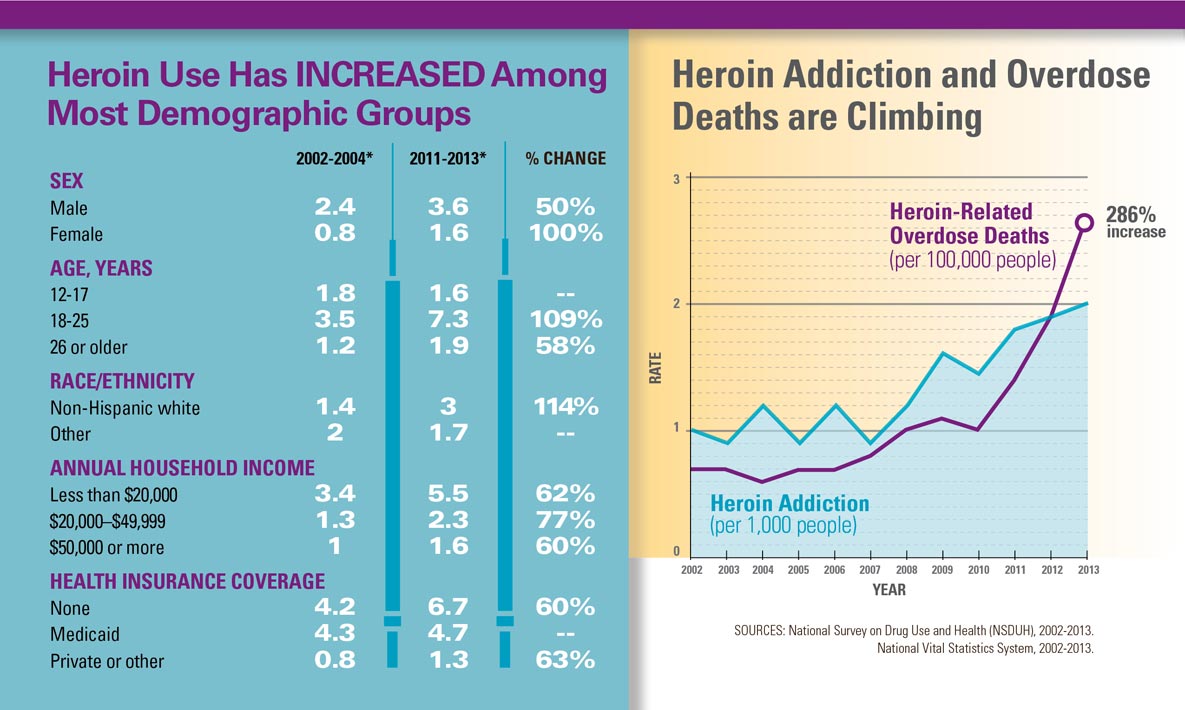New Report Reveals Shocking Statistics on the Growing Heroin Epidemic

By:
The Centers for Disease Control and Prevention on Tuesday released a new report about the dramatic increase in heroin use in the U.S. Using data from annual surveys of 67,000 Americans, the report revealed that between 2003 and 2013 heroin use surged in nearly all demographics: "men and women, most age groups, and all income levels." Heroin use has expanded greatly amongst whites, and it has nearly doubled in women. The number of those between the ages of 18 to 25 using heroin also doubled, the study reported.
The study also found that those who are using heroin are also much more likely to be using other drugs as well: nine out of 10 heroin users were also abusing other drugs. According to the CDC report, "45 percent of people who used heroin were also addicted to prescription opioid painkillers," like OxyContin, and people who abuse painkillers are 40 times more likely to use heroin. Fatalities due to heroin have quadrupled; in 2013 there were more than 8,200 deaths due to heroin.
Earlier this year, ATTN: interviewed New York Times journalist Sam Quinones, who wrote the book "Dreamland: The True Tale of America’s Opiate Epidemic," about the country's heroin epidemic -- especially the connection between prescription painkillers and heroin use. Quinones spent part of his book zoomed in on the Xalisco Boys, a network from the Mexican state of Nayarit who began selling black tar heroin into the U.S. during the early 1990s.
"I focused on the Xalisco Boys because they were the first ones to understand, in a systematic way, the pill market as a precursor to the heroin market, and go to areas where pills were creating a lot of addicts, and sell heroin there," Quinones told ATTN: in May. "Xalisco Boys are not the only ones selling heroin anymore."
 U.S. Center for Disease Control and Prevention - cdc.gov
U.S. Center for Disease Control and Prevention - cdc.gov
Quinones also makes the point partially demonstrated by the study: the problem is not new and it may only get worse.
"It’s been a long time now," he said. "People act as if this is somehow this new thing these last couple of years. This problem has been developing since the mid-90s, but we just haven’t really had to pay attention to it until recently. Now that there are lots of people dying of heroin, I have no doubt that that’s going to continue. Heroin overdose deaths are now the leading cause of accidental death in Ohio."
The growing heroin epidemic in the U.S. has even reached the ears of former Secretary of State and current 2016 presidential candidate, Hillary Clinton. In May, Clinton's aides stated that they are drafting policy on the growing opiate addiction problem in the U.S., according to the Huffington Post.
"There is a hidden epidemic," Clinton said. "We know the drug use problem, whether it’s pills or meth or heroin, is not as visible as 30 years ago when there were all kinds of gangs and violence. This is a quiet epidemic and it is striking in small towns and rural areas as much as any big city. I think a lot of people are thinking, well, that’s somebody else’s problem, that’s not my problem.
"And indeed, it is all of our problem and we don’t have enough resources, so that if somebody decides that they wanted to get help, where do you send them to?" Clinton continued. "What kind of opportunities do they have for treatment? And I am convinced that the mental health issues -- because I consider substance abuse part of mental health issues -- is going to be a big part of my campaign, because increasingly it’s a big issue that people raise with me."
